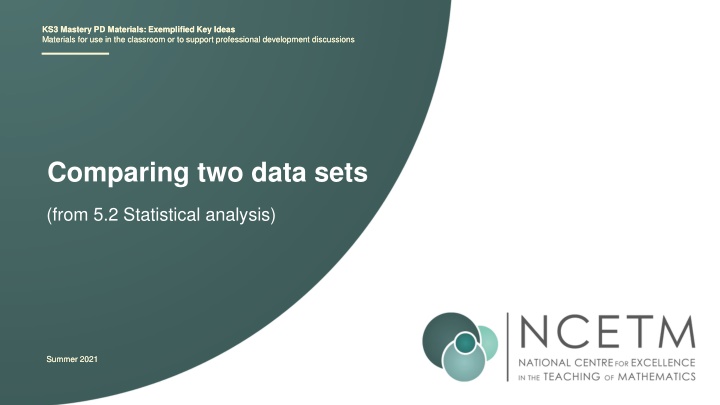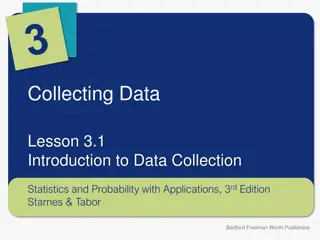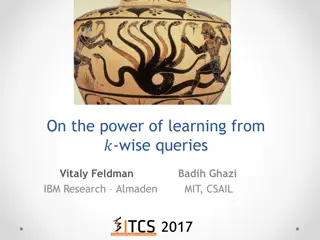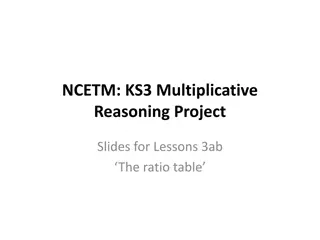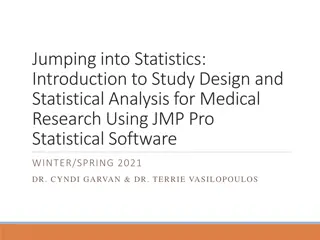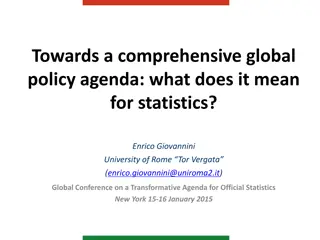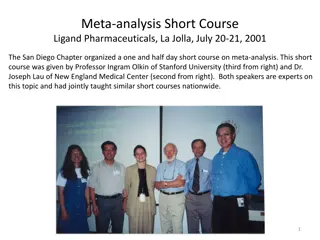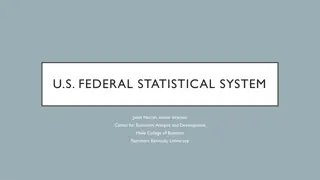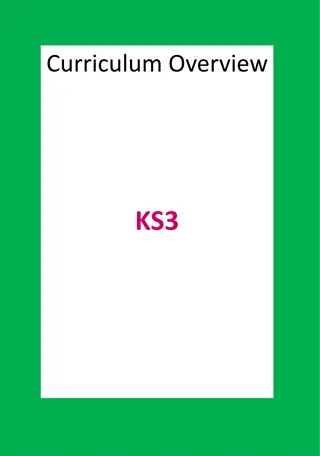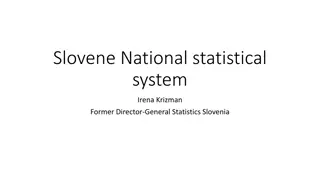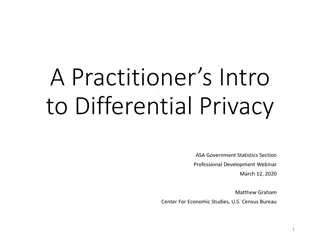Key Ideas for Statistical Analysis in KS3
These slides provide exemplified key ideas for comparing two data sets in the context of Statistical Analysis for KS3. Designed to support professional development discussions or classroom use, the resource offers prompt questions, clarification notes, and references to enhance understanding of core concepts. Explore the importance of statistics and probability in mathematics education through structured presentations that address misconceptions, prior learning, reflection questions, and more.
Download Presentation

Please find below an Image/Link to download the presentation.
The content on the website is provided AS IS for your information and personal use only. It may not be sold, licensed, or shared on other websites without obtaining consent from the author.If you encounter any issues during the download, it is possible that the publisher has removed the file from their server.
You are allowed to download the files provided on this website for personal or commercial use, subject to the condition that they are used lawfully. All files are the property of their respective owners.
The content on the website is provided AS IS for your information and personal use only. It may not be sold, licensed, or shared on other websites without obtaining consent from the author.
E N D
Presentation Transcript
KS3 Mastery PD Materials: Exemplified Key Ideas Materials for use in the classroom or to support professional development discussions Materials for use in the classroom or to support professional development discussions KS3 Mastery PD Materials: Exemplified Key Ideas Comparing two data sets (from 5.2 Statistical analysis) Summer 2021 Summer 2021
About this resource These slides are designed to complement the 5.2 Statistical analysis Core Concept document and its associated Theme Overview document 5 Statistics and probability, both found in the Secondary Mastery Professional Development pages. These slides re-present the key examples from the Core Concept document so that the examples can be used either directly in the classroom or with a group of teachers. There are prompt questions alongside the examples, and further clarification in the notes. These slides do not fully replicate the Core Concept document, so should be used alongside it. Reference to specific page numbers, and to other useful NCETM resources, can be found in the notes for each slide. This slide deck is not designed to be a complete PD session, rather it is a selection of resources that you can adapt and use as needed when planning a session with a group of teachers.
About this resource The slides are structured as follows: The big picture: Where does this fit in? What do students need to understand? Why is this key idea important? Prior learning Misconceptions Exemplified key ideas Reflection questions Appendices: Key vocabulary Representations and structure Previous and Future learning Useful links The exemplified key idea slides have the following symbols to indicate how they have been designed to be used: Into the classroom The examples are presented on these slides so that they could be used in PD, but also directly in the classroom. The notes feature suggested questions and things teachers might consider when using with students. PDdiscussion prompts These slides look at the examples in more detail, with question prompts to promote discussion among maths teachers. The notes feature reference to further information and guidance within the Core Concepts document.
Where does this fit in? The NCETM has identified a set of six mathematical themes within Key Stage 3 mathematics that bring together a group of core concepts . The fifth of these themes is Statistics and probability, which covers the following interconnected core concepts: 5.1 Statistical representations and measures 5.2 Statistical analysis 5.3 Probability
Where does this fit in? Within this core concept, 5.2 Statistical analysis, there are two statements of knowledge, skills and understanding. These, in turn, are broken down into eleven key ideas. The highlighted key idea is exemplified in this slide deck.
What do students need to understand? 5.2.1.5 Use the different measures of central tendency and spread to compare two sets of data What prior knowledge might your students already have? What language might they use to describe this key idea? What questions might you want to ask to assess their prior learning? Accurately compare two data sets using one or more summary statistic. Understand that data sets can have the same measures of central tendency but a different measure of spread. Understand range is a measure of spread and not a measure of central tendency. Solve familiar and unfamiliar problems, including real- life applications. Solve problems where there is more than one answer and where there are elements of experimentation, investigation, checking, reasoning, proof, etc.
Why is this key idea important? (1) A key skill for students to develop at Key Stage 3 is the ability to make an informed choice of what statistical analysis and representation to use for discrete, continuous and grouped data. Being able to construct representations and calculate values that indicate a measure of central tendency or measure of spread is important in order to represent and summarise data accurately. Just as important is the need for students to be able to make an informed choice about what statistical tools to use, and understand the effect that these choices have on the interpretation, and misinterpretation, of data, including the potential impact of outliers. Students should be presented with summary data to interrogate, so they can appreciate the limitations of such information when the raw data is no longer available. Dealing with inaccuracies, outliers and other contextual issues will give students a greater appreciation of the realistic nature of statistical analysis. Students should appreciate the differences between a frequency-based chart (such as a bar chart or pictogram) and a proportional chart (such as a pie chart) and how different aspects of the data can, and cannot, be inferred from each.
Why is this key idea important? (2) Situations that require statistical techniques to be employed will probably begin with an issue, a question or a problem. These situations require a number of decisions to be made: Which data do I need to collect? How will I organise this data? How will I analyse this data in order to address the original question/problem? Which representation should I choose in order to address the original question/problem and communicate clearly my findings? Students should have the opportunity to consider all of these aspects at different stages of their work on statistics. The use of real-life contexts and issues are important to give statistics meaning. Students should be given opportunities to solve problems that do not necessarily have a correct answer, but be required to justify decisions made and be prepared to be challenged.
Prior learning Upper Key Stage 2 Learning Outcome Interpret and present discrete and continuous data using appropriate graphical methods, including bar charts and time graphs Solve comparison, sum and difference problems using information presented in bar charts, pictograms, tables and other graphs Solve comparison, sum and difference problems using information presented in a line graph What prior knowledge might your students already have? What language might they use to describe this key idea? What questions might you want to ask to assess their prior learning? Complete, read and interpret information in tables, including timetables Interpret and construct pie charts and line graphs and use these to solve problems Calculate and interpret the mean as an average
Prior learning Key Stage 3 Learning Outcome 5.1.1 Understand and calculate accurately measures of central tendency and spread What representations might your students already be familiar with? What language might they use? How does this fit in with your curriculum progression? 5.1.2 Construct accurately statistical representations Please note: Numerical codes refer to statements of knowledge, skills and understanding in the NCETM breakdown of Key Stage 3 mathematics.
Checking prior learning The following slides contain questions for checking prior learning. What representations might students use to support their understanding of these questions? What variation might you put in place for these questions to fully assess students understanding of the concept? How might changing the language of each question change the difficulty? Why are these such crucial pre-requisites for this key idea?
Checking prior learning c) From 7 March 2016 to 7 March 2017 a swimming club had the same members. Complete the table to show the information about the members of the club. Explain your reasoning. a) Write down five integers with a mean of 6 and a median of 4 and a mode of 2 and a range of 13 Justify your answers. Age of member Mean (March 2016) Range (March 2016) Mean (March 2017) Range (March 2017) 14 years 7 months 4 years 2 months b) Last year, Jacob went to four concerts. Three of his tickets cost 5 each. The other ticket cost 7. (QCA, 2002) What was the mean cost of the tickets? Show your method.
Common difficulties and misconceptions What aspects of this key idea might students find challenging? What misconceptions might students have? When teaching this topic, you may find students encounter difficulties with 1) Understanding that range is NOT a measure of central tendency 2) Interpreting, and not just calculating, summary values More information, and some suggestions for overcoming these challenges, can be found on the following slides.
Common difficulties and misconceptions (1) Students often learn to calculate the range alongside the different averages and do not always understand the distinction between the range as a measure of spread and the averages as a measure of central tendency. Representing the data as points on a number line can help students to have a visual sense of the range and so more easily distinguish it from a measure of central tendency Many of the examples in this slide deck provide opportunities to talk explicitly about the range and how it differs from the mean, median and mode such as example 5, where the range is the only value that is varied whilst the other values stay the same.
Common difficulties and misconceptions (2) Students should be encouraged to interpret summary values and draw conclusions from them rather than just being able to mechanically calculate them. Reversing the process and asking students to construct a data set to match a set of summary statistics gives students a much deeper understanding of the summary values. Asking students to match a data set, the summary data and an associated graphical representation can be a powerful activity to support students with making connections and going beyond mechanically calculating measures of central tendency. This is exemplified further in example 4 (slide 23).
Accurately compare two data sets using one or more summary statistic Example 1: The daily temperatures across March last year for two cities are summarised in this table. City Mean maximum daily temperature Range of maximum daily temperature 22 C 6 C A 22 C 13 C B Which city should you choose to visit if you want to enjoy high temperatures? Justify your answer. ncetm.org.uk
Accurately compare two data sets using one or more summary statistic Example 1: What language might you want students to use to describe these data sets? The daily temperatures across March last year for two cities are summarised in this table. City Mean maximum daily temperature Range of maximum daily temperature What examples of data sets with summary statistics do students currently experience? 22 C 6 C A 22 C 13 C B How can you broaden this experience? Which city should you choose to visit if you want to enjoy high temperatures? Justify your answer. ncetm.org.uk
Accurately compare two data sets using one or more summary statistic Example 2: The daily temperatures across March last year for two cities are summarised in this table. City Mean maximum daily temperature Range of maximum daily temperature C 12 C 8 C D 21 C 8 C Which city should you choose to visit if you want to enjoy high temperatures? Justify your answer. ncetm.org.uk
Accurately compare two data sets using one or more summary statistic Example 2: What language might you want students to use to describe these data sets? What questions might you ask to ensure that students understand the difference between what range and mean measure? The daily temperatures across March last year for two cities are summarised in this table. City Mean maximum daily temperature Range of maximum daily temperature C 12 C 8 C D 21 C 8 C Which city should you choose to visit if you want to enjoy high temperatures? Justify your answer. ncetm.org.uk
Accurately compare two data sets using one or more summary statistic Example 1: City Mean maximum daily temperature 22 C 22 C Range of maximum daily temperature 6 C 13 C What is the same/different about these data sets? A B What are they designed to draw students attention to? Example 2: What language might you support pupils to use to describe these data sets? City Mean maximum daily temperature 12 C 21 C Range of maximum daily temperature 8 C 8 C C D ncetm.org.uk
Accurately compare two data sets using one or more summary statistic Example 3: The daily temperatures last week for two other cities are summarised in this table. City Mean maximum daily temperature Modal maximum daily temperature 24 C 18 C E 20 C 23 C F How would you argue that city E enjoyed warmer days last week? How could you argue that city F did? ncetm.org.uk
Accurately compare two data sets using one or more summary statistic Example 3: The daily temperatures last week for two other cities are summarised in this table. How can your questioning support students to understand subtle differences in averages? City Mean maximum daily temperature Modal maximum daily temperature What is the benefit of asking students to argue two different conclusions from the same data set? 24 C 18 C E 20 C 23 C F How would you argue that city E enjoyed warmer days last week? How could you argue that city F did? ncetm.org.uk
Understand that data sets can have the same measures of central tendency but a different measure of spread Example 4 a) Match the charts with the correct measures of central tendency and spread. b) Find the missing values. Source: Adapted from Improving Learning in Mathematics (The Standards Unit box) S4 Understanding mean, median, mode and range DfES Standards Unit Public sector information licensed under the Open Government Licence v3.0 ncetm.org.uk
Understand that data sets can have the same measures of central tendency but a different measure of spread Example 4 Bar chart A Bar chart B Bar chart C Bar chart D Bar chart E Stats A Stats B Stats C Stats D Stats E Mean 3 Mean Mean Mean Mean Median 4 Median Median Median Median Mode 4 Mode Mode Mode Mode Range 3 Range Range Range Range Source: Adapted from Improving Learning in Mathematics (The Standards Unit box) S4 Understanding mean, median, mode and range DfES Standards Unit Public sector information licensed under the Open Government Licence v3.0 ncetm.org.uk
Understand that data sets can have the same measures of central tendency but a different measure of spread Example 4 What strategies would you expect students to use? a) b) Match the charts with the correct measures of central tendency and spread. Find the missing values What is the effect of the variation in this example? What features might you want to draw students attention to in your questioning? Source: Adapted from Improving Learning in Mathematics (The Standards Unit box) S4 Understanding mean, median, mode and range DfES Standards Unit Public sector information licensed under the Open Government Licence v3.0 ncetm.org.uk
Understand that data sets can have the same measures of central tendency but a different measure of spread Example 4 (cont.) Watch video 2 of Insights from experienced teachers | NCETM. These materials are discussed from 8:00. Do you agree with the teachers reflections on this task? How do you ensure students know the difference between measures of central tendency and spread? a) b) Match the charts with the correct measures of central tendency and spread. Find the missing values Source: Adapted from Improving Learning in Mathematics (The Standards Unit box) S4 Understanding mean, median, mode and range DfES Standards Unit Public sector information licensed under the Open Government Licence v3.0 ncetm.org.uk
Understand range is a measure of spread and not a measure of central tendency Example 5 The test scores for two classes are summarised in this table. Class A Class B 70 70 70 15 70 70 70 10 Mean Mode Median Range Archie thinks some students in class A have scored higher than class B because it has a larger range. Do you agree? Explain your answer. ncetm.org.uk
Understand range is a measure of spread and not a measure of central tendency Example 5 The test scores for two classes are summarised in this table. How would you support students who were struggling with this question? Class A 70 70 70 15 Class B 70 70 70 10 Mean Mode Median Range What language might you encourage students to use in their explanations? Archie thinks some students in class A have scored higher than class B because it has a larger range. Do you agree? Explain your answer. ncetm.org.uk
Solve familiar and unfamiliar problems, including real-life applications Example 6 Three students each run five speed trials. These are the times (in seconds) for their five runs. Abdul Beattie 92 99 86 79 89 80 87 96 91 96 Chris 84 92 90 92 97 Who is the fastest runner? Can you provide reasons (with evidence) for why each student might be the fastest? ncetm.org.uk
Solve familiar and unfamiliar problems, including real-life applications Example 6 Three students each run five speed trials. These are the times (in seconds) for their five runs. Abdul 92 86 89 87 91 Beattie 99 79 80 96 96 Chris 84 92 90 92 97 What support might students need to get started on this task? What other problems could you devise, in contexts suitable for your classes? Who is the fastest runner? Can you provide reasons (with evidence) for why each student might be the fastest? ncetm.org.uk
Solve problems where there is more than one answer and where there are elements of experimentation, investigation, checking, reasoning, proof, etc Example 7 Is this statement always, sometimes or never true? The measure of spread of a data set is greater than any of the measures of central tendency of the data set. Explain your answer. ncetm.org.uk
Solve problems where there is more than one answer and where there are elements of experimentation, investigation, checking, reasoning, proof, etc Example 8 Is this statement always, sometimes or never true? Two data sets with the same measure of spread and measures of central tendency have the same maximum and minimum values. Explain your answer. ncetm.org.uk
Solve problems where there is more than one answer and where there are elements of experimentation, investigation, checking, reasoning, proof, etc Example 7 Is this statement always, sometimes or never true? The measure of spread of a data set is greater than any of the measures of central tendency of the data set. Explain your answer. What misconceptions or assumptions might these statements expose? Can you create your own always, sometimes or never statement to further explore the structure of measures of spread/central tendency? Example 8 Is this statement always, sometimes or never true? Two data sets with the same measure of spread and measures of central tendency have the same maximum and minimum values. Explain your answer. ncetm.org.uk
Reflection questions What other mathematical concepts will be supported by students stronger understanding of this key idea? What mathematical language will you continue to use to support pupils to make connections with other areas? Which representations might you continue to use to further develop students understanding?
Appendices You may choose to use the following slides when planning or delivering a PD session. They cover: Key vocabulary Representations and structure Previous learning Future learning Quick prepare card sort for Example 4 Library of links
Key vocabulary (1) Term (arithmetic) mean Definition The sum of a set of numbers, or quantities, divided by the number of terms in the set. Example: The arithmetic mean of 5, 6, 14, 15 and 45 is (5 + 6 + 14 + 15 + 45) 5 i.e. 17. Involving two random variables; used in statistics as a bivariate distribution. bivariate dispersion Dispersion (also called variability , scatter or spread ) is the extent to which the data in a distribution is spread out. A simple measure of spread is the range. Other common measures are the variance, standard deviation and interquartile range. In statistics, a measure of how the values of a particular variable are located in terms of the values collected for a particular sample, or for the relevant population as a whole. measure of central tendency In school mathematics up to Key Stage 4, there are three important measures of central tendency: the arithmetic mean, the median and the mode. These are all statistical averages and often one is more useful than another, depending on the spread of the values under consideration.
Key vocabulary (2) Term median Definition The middle number or value when all values in a set of data are arranged in ascending order. Example: The median of 5, 6, 14, 15 and 45 is 14. When there is an even number of values, the arithmetic mean of the two middle values is calculated. Example: The median of 5, 6, 7, 8, 14 and 45 is (7 + 8) 2, i.e. 7.5 The median is one example of an average. The most commonly occurring value or class with the largest frequency. mode Example: The mode of this set of data: 2, 3, 3, 3, 4, 4, 5, 5, 6, 7, 8 is 3. Some sets of data may have more than one mode. In statistical samples, an outlier is an exceptional trial result that lies beyond where most of the results are clustered. outlier Example: Six people have the following salaries: 20000, 25600, 2000, 19000, 30000, 160000. The salary of 160000 is clearly out of line with the others and is an outlier. At the other end, 2 000 is also well below the central cluster of values and so may also be considered as an outlier. A measure of spread in statistics. The difference between the greatest value and the least value in a set of numerical data. range
Representations and structure There are a number of different statistical representations that students might encounter as part of their exploration of statistical analysis. It will be important that students understand how to identify measures of central tendency and spread, where possible, in each of these representations. Pie charts Pie charts allow for comparisons between proportions. They are particularly relevant for students when they are working with populations of different sizes, or for making multiplicative comparisons within the same population. Bar charts Bar charts can be used give students a sense of the shape of the distribution of the data across a sample, to identify and compare frequencies. They give an opportunity for comparisons to be made using absolute values. Pictograms Pictograms are a simple way of recording frequencies, tabulating images that represent a certain frequency.
Previous learning From Upper Key Stage 2, students will bring experience of: interpreting and presenting discrete and continuous data using appropriate graphical methods, including bar charts, pictograms and time graphs solving comparison, sum and difference problems using information presented in bar charts, pictograms, tables and other graphs interpreting and constructing pie charts and line graphs, and using these to solve problems encountering and drawing graphs relating two variables, arising from their own enquiry and in other subjects (non-statutory guidance) calculating and interpreting the mean as an average knowing when it is appropriate to find the mean of a data set (non-statutory guidance).
Future learning (1) In KS4, students will build on the core concepts in this mathematical theme to: infer properties of populations or distributions from a sample, whilst knowing the limitations of sampling interpret and construct tables and line graphs for time series data {construct and interpret diagrams for grouped discrete data and continuous data, i.e. histograms with equal and unequal class intervals and cumulative frequency graphs, and know their appropriate use} Please note: Braces { } indicate additional mathematical content to be taught to more highly attaining students.
Future learning (2) In KS4, students will build on the core concepts in this mathematical theme to: interpret, analyse and compare the distributions of data sets from univariate empirical distributions through: appropriate graphical representation involving discrete, continuous and grouped data, {including box plots} appropriate measures of central tendency (including modal class) and spread {including quartiles and inter-quartile range} apply statistics to describe a population use and interpret scatter graphs of bivariate data; recognise correlation and know that it does not indicate causation; draw estimated lines of best fit; make predictions; interpolate and extrapolate apparent trends whilst knowing the dangers of so doing Please note: Braces { } indicate additional mathematical content to be taught to more highly attaining students.
Instructions for quick prepare card sort for Example 4 Example 4 asks students/teachers to match bar charts with data sets. Slides 23-24 provide an on-screen version of this task. You may find it helpful for students/teachers to be able to physically manoeuvre each bar chart/data set as a card sort. Card sorts can be time consuming to prepare, but if you feel they will be beneficial to the purpose of the activity, this method should save some time: Print slides 44-53 (single sided, 1 slide per page) Stack the ten pages on top of each other. Place paper clips at the end of each of the three rows (to keep them together when cut). Use a guillotine to carefully slice into three rows. Place paper clips in each of the remaining four squares of each strip of paper. Slice the three rows into five squares you should now have 15 sets of card sorts, without any sorting! ncetm.org.uk
Bar chart A Bar chart A Bar chart A Bar chart A Bar chart A Bar chart A Bar chart A Bar chart A Bar chart A Bar chart A Bar chart A Bar chart A Bar chart A Bar chart A Bar chart A
Bar chart B Bar chart B Bar chart B Bar chart B Bar chart B Bar chart B Bar chart B Bar chart B Bar chart B Bar chart B Bar chart B Bar chart B Bar chart B Bar chart B Bar chart B
Bar chart C Bar chart C Bar chart C Bar chart C Bar chart C Bar chart C Bar chart C Bar chart C Bar chart C Bar chart C Bar chart C Bar chart C Bar chart C Bar chart C Bar chart C
Bar chart D Bar chart D Bar chart D Bar chart D Bar chart D Bar chart D Bar chart D Bar chart D Bar chart D Bar chart D Bar chart D Bar chart D Bar chart D Bar chart D Bar chart D
Bar chart E Bar chart E Bar chart E Bar chart E Bar chart E Bar chart E Bar chart E Bar chart E Bar chart E Bar chart E Bar chart E Bar chart E Bar chart E Bar chart E Bar chart E
Stats A Stats A Stats A Stats A Stats A Mean 3 Mean 3 Mean 3 Mean 3 Mean 3 Median 4 Median 4 Median 4 Median 4 Median 4 Mode 4 Mode 4 Mode 4 Mode 4 Mode 4 Range 3 Range 3 Range 3 Range 3 Range 3 Stats A Stats A Stats A Stats A Stats A Mean 3 Mean 3 Mean 3 Mean 3 Mean 3 Median 4 Median 4 Median 4 Median 4 Median 4 Mode 4 Mode 4 Mode 4 Mode 4 Mode 4 Range 3 Range 3 Range 3 Range 3 Range 3 Stats A Stats A Stats A Stats A Stats A Mean 3 Mean 3 Mean 3 Mean 3 Mean 3 Median 4 Median 4 Median 4 Median 4 Median 4 Mode 4 Mode 4 Mode 4 Mode 4 Mode 4 Range 3 Range 3 Range 3 Range 3 Range 3
Stats B Stats B Stats B Stats B Stats B Mean Mean Mean Mean Mean Median Median Median Median Median Mode Mode Mode Mode Mode Range Range Range Range Range Stats B Stats B Stats B Stats B Stats B Mean Mean Mean Mean Mean Median Median Median Median Median Mode Mode Mode Mode Mode Range Range Range Range Range Stats B Stats B Stats B Stats B Stats B Mean Mean Mean Mean Mean Median Median Median Median Median Mode Mode Mode Mode Mode Range Range Range Range Range
